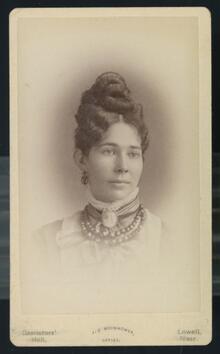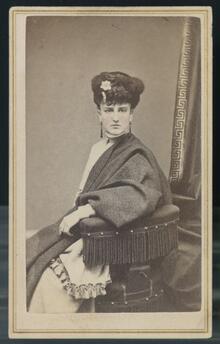Dana Porter Library, first floor
University of Waterloo Library
Waterloo, Ontario N2L 3G1
519-888-4567 x42619 or x42445
Recent blog posts
Blog topics
-
1492LandBackLane (1)
-
1900s (2)
-
Abyssinia (1)
-
advertisements (1)
-
album (1)
-
anatomy (1)
-
anniversary (1)
-
anti-suffragists (1)
-
archives (25)
-
arithmetic (1)
-
art (1)
-
autographs (2)
-
automation (1)
-
awards (1)
-
badges (1)
-
bank fraud (1)
-
barcodes (1)
-
beer (1)
-
Birth Control (1)
-
BLIND DATE (1)
-
book collection (1)
-
books (19)
-
bookworms (1)
-
botany (1)
-
Britain (1)
-
British history (1)
-
Burns (1)
-
Cambodia (1)
-
Canadian history (1)
-
casinos (1)
-
Catholicism (1)
-
censorship (1)
-
Charles Dodgson (1)
-
Chinese history (1)
-
clothing (2)
-
co-op (2)
-
co-op students (2)
-
cocoa (1)
-
community (1)
-
conservation (1)
-
correspondence (1)
-
COVID-19 (1)
-
Crochet (1)
-
culture (1)
-
Dance (1)
-
dancing (1)
-
detective (1)
-
dolls (1)
-
Drama (1)
-
Drawing (1)
-
ectoplasm (1)
-
Eid (1)
-
Eid Celebration (1)
-
eldritch horror (1)
-
employment (1)
-
Englishmen (1)
-
Eric McCormack (1)
-
Euclid (1)
-
Eugenics (1)
-
examinations (1)
-
exams (1)
-
exercise (1)
-
facsimiles (1)
-
fairy tales (1)
-
farms (1)
-
Fashion (1)
-
FINE ARTS (1)
-
fire (1)
-
five year plans (1)
-
flowcharts (1)
-
Frenchmen (1)
-
gas masks (1)
-
geese (1)
-
gender studies (1)
-
gender violence (1)
-
geography (1)
-
ghosts (2)
-
H.P. Lovecraft (1)
-
hidden art (1)
-
HIST250 (1)
-
history (6)
-
holy books (1)
-
horror fiction (2)
-
hydrography (1)
-
illustrations (1)
-
Indigenous (1)
-
inflation (1)
-
insects (1)
-
introduction (1)
-
journalists (1)
-
Kaufman Shoes (1)
-
Kitchener (2)
-
knitting (1)
-
Lady Aberdeen (1)
-
landscapes (1)
-
Latin (1)
-
Lewis Carroll (1)
-
LGBT studies (1)
-
libraries (1)
-
local history (1)
-
Lydia Dotto (1)
-
magazines (1)
-
magic (1)
-
mandibles (1)
-
marbling (1)
-
Marie Stopes (1)
-
media (1)
-
medicine (2)
-
Michael Fritsch (1)
-
midwifery (1)
-
murder (2)
-
mushroom (1)
-
mysteries (1)
-
mysticism (1)
-
Noel Hynes (1)
-
Novels (1)
-
nursery rhymes (1)
-
occult (2)
-
opera singers (1)
-
optimism (1)
-
outreach (1)
-
oxygen (1)
-
paleontology (1)
-
pharmacy (1)
-
photographs (5)
-
planning (1)
-
playboys (1)
-
Poetry (1)
-
pop-up books (1)
-
prejudice (1)
-
Pride (4)
-
pulp (1)
-
quietism (1)
-
quotes (1)
-
radio (1)
-
Ramadan (1)
-
rare books (11)
-
rates (1)
-
rationing (1)
-
religion (1)
-
repurposing (1)
-
research (1)
-
restaurants (1)
-
Romance (1)
-
rubber (1)
-
Sardinia (1)
-
satire (1)
-
science (1)
-
scrapbook (1)
-
scrapbooks (1)
-
seances (1)
-
Second World War (1)
-
Shoes (1)
-
smuggling (1)
-
Sorels (1)
-
spatulas (1)
-
spelling (1)
-
spiritualism (3)
-
spirituality (1)
-
staff (1)
-
Stamps (1)
-
steamships (1)
-
Stephen King (1)
-
Stranger Things (1)
-
students (3)
-
suffragists (3)
-
surveys (1)
-
telephones (1)
-
theatre (1)
-
theosophy (2)
-
Transcription (1)
-
trumpets (1)
-
typefaces (1)
-
urban planning (1)
-
vases (1)
-
volleyball (1)
-
waltzing (1)
-
wand (1)
-
water towers (1)
-
Waterloo (1)
-
Wedding (1)
-
women (1)
-
Women Studies (1)
-
women's studies (6)
-
Womens Rights (1)
-
world war i (1)
-
World War II (4)
-
WS (2)
-
zero gravity (1)
Blog posts by audience
- Post-doctoral fellows (1)
- Current students (12)
- Everyone (2)
- Future students (9)
- Faculty (10)
- Staff (10)
- Alumni (10)
- Parents (8)
- Donors | Friends | Supporters (9)
- Employers (7)
- International (7)
- Media (8)
Blog posts archive
(Continuation of Types of Photographs - Part 1)
Cartes-de-visite
Cartes-de-visite were one of the most popular types of photographs and entered the scene in the 1850s. Their small size, measuring at approximately two by four inches, made them easy to share and collect amongst family and friends. It is also the size that sets them apart from other types of photographs. Albumen prints were one of the most common types of prints mounted on a carte-de-visite. These prints are very thin which is why they are commonly found mounted on thicker cardstock. It is interesting to note that egg whites are used in the making of albumen prints. This in turn can alter the print to a yellowish tone with deterioration over time.
These examples of cartes-de-visite are from the Photograph Collection.




Cabinet Cards
In the 1860s, Cabinet cards made their debut. Cabinet cards were considered to be the new and improved form of cartes-de-visite. Their larger size and enhanced colouring displayed an advancement in photographic prints. The measurement of a cabinet card was approximately four by six inches, similar to the most common size of photo print today. The name is very literal as they were most often kept in cabinets. One fairly prevalent aspect not only with cabinet cards, but cartes-de-visite as well, was the use of vignette. Vignette is fading around the photograph which is commonly done in white or black. In addition, a photographer’s stamp can frequently be found on the mount of both types of photographs.
The first 3 examples are unidentified individuals from the Photograph Collection; the fourth is from the Schantz Russell family fonds : 2011 accrual.




Prints
Photographic prints were typically a printing out process (POP), meaning that they were produced through negatives as opposed to a directly developed photograph which is called a developing out process (DOP). Prints can be found loose or mounted (for example on a carte-de-visite or cabinet card). Some different types of prints include salt prints, silver gelatin, platinum, albumen, and collodion. Although some may be difficult to differentiate, others have determining features. Prints can deteriorate in varying ways such as silver gelatin prints displaying a mirroring effect or the yellowing of an albumen print. Prints have been ever changing since the 19th century and continue to be a window into historic photographic processes.
The first three of these examples of prints are from the Schantz Russell Family fonds : 2011 accrual. The fourth is from the Breithaupt Heweston Clark collection.
One photograph with four frames of Ruth Schantz. Four separate images of Ruth in different poses have been taken, and have been developed together on one photographic paper. The image is mounted on a large board around which Carrie Flagler Schantz has painted pink flowers, copied two lines from the poem, Seven Times One by Jean Ingelow and recorded the date as September 30, 1899. The two lines from the poem are, “I've said my seven times over and over; Seven times one are seven.”
Three photographs that have been hole punched and tied together. The first shows Ruth Schantz sitting in a wheelbarrow with Carrie Flagler Schantz in front of the home at Morton Park. The second shows Ruth Schantz and Orpheus Moyer Schantz on the steps of the home at Morton Park. The third shows Ruth standing in a garden holding flowers.
One snapshot of Ruth Schantz holding her newborn cousin Dorothy White. Image of the children is only 5 cm in diameter surrounded by a border of leaves. Photograph is possibly a photogram.
The various processes employed in the creation of all these different types result in uniquely stunning photographs. They offer a glimpse of the photographic processes used, as well as the evolution of photography presented throughout the years. Special Collections & Archives houses incredible material that has the potential to connect us to various historic areas of interest, photography being one of them.
References
https://www.parisphoto.com/en/Glossary/ [This link broken as of 2020-06-12]
http://www.graphicsatlas.org/identification/
https://psap.library.illinois.edu/collection-id-guide/photoprint
https://blog.scienceandmediamuseum.org.uk/find-out-when-a-photo-was-taken-identify-a-cabinet-card/








